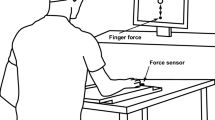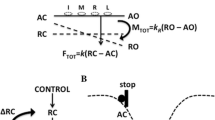Abstract
We explored the phenomenon of unintentional force drift seen in the absence of visual feedback during knee extension contractions in isometric conditions. Based on the importance of knee extensors for the anti-gravity function, we hypothesized that such force drifts would be slower and smaller compared to those reported for the upper extremities. We also explored possible effects of foot dominance and gender on the force drifts. Young healthy persons produced isometric knee extension contractions to different levels, ranging from 15 to 25% of maximal voluntary contraction force, with the help of visual feedback, and then, the visual feedback was turned off. Force change over the time interval without visual feedback was quantified. In the absence of visual feedback, force drifted to smaller magnitudes. The drift magnitude expressed in percent of the initial force magnitude was smaller for smaller initial force levels, ranging between 8 and 15% of the initial force for the initial force magnitude of 15% and 25% of maximal voluntary contraction force. The time exponent of the force drift was independent of the initial force magnitude and was, on average, 6.45 s. There were no significant effects of foot dominance or gender, although the male subjects tended to show stronger scaling of the drift magnitude with the initial force level compared to the female subjects. The results show that unintentional force drift is a common phenomenon across limbs and muscle groups. This conclusion fits the theory of control with spatial referent coordinates and the general tendency of all natural systems to drift to states with lower potential energy.






Similar content being viewed by others
Availability of data and materials
The original data are available from the corresponding author at a reasonable request. IR confirm the authenticity of all the raw data during this study.
References
Abolins V, Latash ML (2022) Unintentional force drifts as consequences of indirect force control with spatial referent coordinates. Neurosci 481:156–165
Ambike S, Paclet F, Zatsiorsky VM, Latash ML (2014) Factors affecting grip force: anatomy, mechanics, and referent configurations. Exp Brain Res 232:1219–1231
Ambike S, Zatsiorsky VM, Latash ML (2015) Processes underlying unintentional finger force changes in the absence of visual feedback. Exp Brain Res 233:711–721
Ambike S, Mattos D, Zatsiorsky VM, Latash ML (2016) Unsteady steady-states: Central causes of unintentional force drift. Exp Brain Res 234:3597–3611
Corcos DM, Gottlieb GL, Agarwal GC, Flaherty BP (1990) Organizing principles for single joint movements. IV Implications for Isometric Contractions. J Neurophysiol 64:1033–1042
Cuadra C, Corey J, Latash ML (2021) Distortions of the efferent copy during force perception: a study of force drifts and effects of muscle vibration. Neurosci 457:139–154
De Freitas PB, Freitas SMSF, Lewis MM, Huang X, Latash ML (2018) Stability of steady hand force production explored across spaces and methods of analysis. Exp Brain Res 236:1545–1562
Elias LJ, Bryden MP (1998) Footedness is a better predictor of language lateralisation than handedness. Laterality 3:41–51
Elias LJ, Bryden MP, Bulman-Fleming MB (1998) Footedness is a better predictor than is handedness for emotional lateralization. Neuropsychologia 36:37–43
Feldman AG (1966) Functional tuning of the nervous system with control of movement or maintenance of a steady posture. II. Controllable parameters of the muscle. Biophysics 11:565–578
Feldman AG (1986) Once more on the equilibrium-point hypothesis (λ-model) for motor control. J Motor Behav 18:17–54
Feldman AG (2015) Referent control of action and perception: Challenging conventional theories in behavioral science. Springer, NY
Feldman AG, Latash ML (2005) Testing hypotheses and the advancement of science: Recent attempts to falsify the equilibrium-point hypothesis. Exp Brain Res 161:91–103
Hinder MR, Milner TE (2003) The case for an internal dynamics model versus equilibrium point control in human movement. J Physiol 549:953–963
Iggo A, Muir AR (1969) The structure and function of a slowly adapting touch corpuscle in hairy skin. J Physiol 200:763–796
Jo HJ, Ambike S, Lewis MM, Huang X, Latash ML (2016) Finger force changes in the absence of visual feedback in patients with Parkinson’s disease. Clin Neurophysiol 127:684–692
Jonides J, Smith E, Koeppe R, Awh E, Minoshima S, Mintum M (1993) Spatial working memory in humans as revealed by PET. Nature 363:623–625
Kang Y, Harris LJ (2000) Handedness and footedness in Korean college students. Brain Cogn 43:268–274
Lackner JR, DiZio P (1994) Rapid adaptation to Coriolis force perturbations of arm trajectory. J Neurophysiol 72:1–15
Latash ML (2010) Motor synergies and the equilibrium-point hypothesis. Mot Control 14:294–322
Latash ML (2019) Physics of Biological Action and Perception. Academic Press, New York
Latash ML, Zatsiorsky VM (1993) Joint stiffness: Myth or reality? Hum Move Sci 12:653–692
Owen A, McMillan K, Laird A, Bullmore E (2005) N-back working memory paradigm: a meta-analysis of normative functional neuroimaging. Hum Brain Mapp 25:46–59
Park J, Wu Y-H, Lewis MM, Huang X, Latash ML (2012) Changes in multi-finger interaction and coordination in Parkinson’s disease. J Neurophysiol 108:915–924
Parsa B, Terekhov AV, Zatsiorsky VM, Latash ML (2017) Optimality and stability of intentional and unintentional actions: I. Origins of drifts in performance. Exp Brain Res 235:481–496
Pilon J-F, De Serres SJ, Feldman AG (2007) Threshold position control of arm movement with anticipatory increase in grip force. Exp Brain Res 181:49–67
Poon C, Chin-Cottongim LG, Coombes SA, Corcos DM, Vaillancourt DE (2012) Spatiotemporal dynamics of brain activity during the transition from visually guided to memory-guided force control. J Neurophysiol 108:1335–1348
Rasouli O, Solnik S, Furmanek MP, Piscitelli D, Falaki A, Latash ML (2017) Unintentional drifts during quiet stance and voluntary body sway. Exp Brain Res 235:2301–2316
Reschechtko S, Latash ML (2017) Stability of hand force production: I. Hand level control variables and multi-finger synergies. J Neurophysiol 118:3152–3164
Sainburg RL (2005) Handedness: differential specializations for control of trajectory and position. Exer Sport Sci Rev 33:206–213
Shinohara M, Li S, Kang N, Zatsiorsky VM, Latash ML (2003) Effects of age and gender on finger coordination in maximal contractions and submaximal force matching tasks. J Appl Physiol 94:259–270
Slifkin AB, Vaillancourt DE, Newell KM (2000) Intermittency in the control of continuous force production. J Neurophysiol 84:1708–2171
Solnik S, Qiao M, Latash ML (2017) Effects of visual feedback and memory on unintentional drifts in performance during finger pressing tasks. Exp Brain Res 235:1149–1162
Tran US, Stieger S, Voracek M (2014) Evidence for general right-, mixed-, and left-sidedness in self-reported handedness, footedness, eyedness, and earedness, and a primacy of footedness in a large-sample latent variable analysis. Neuropsychologia 62:220–232
Vaillancourt DE, Russell DM (2002) Temporal capacity of short-term visuomotor memory in continuous force production. Exp Brain Res 145:275–285
Vaillancourt DE, Slifkin AB (2001) Newell KM (2001) Visual control of isometric force in Parkinson’s disease. Neurophysiologia 39:1410–1418
Vaillancourt DE, Thulborn KR, Corcos DM (2003) Neural basis for the processes that underlie visually guided and internally guided force control in humans. J Neurophysiol 90:3330–3340
Zhou T, Zhang L, Latash ML (2015a) Intentional and unintentional multi-joint movements: their nature and structure of variance. Neurosci 289:181–193
Zhou T, Zhang L, Latash ML (2015b) Characteristics of unintentional movements by a multi-joint effector. J Motor Behav 47:352–361
Acknowledgements
The authors would like to thank Jan Martin Jäe for his contribution during the testing of participants.
Funding
This study received no external funding support.
Author information
Authors and Affiliations
Corresponding author
Ethics declarations
Conflict of interest
The authors declare that they have no competing interests.
Additional information
Communicated by Bill J Yates.
Publisher's Note
Springer Nature remains neutral with regard to jurisdictional claims in published maps and institutional affiliations.
Rights and permissions
Springer Nature or its licensor (e.g. a society or other partner) holds exclusive rights to this article under a publishing agreement with the author(s) or other rightsholder(s); author self-archiving of the accepted manuscript version of this article is solely governed by the terms of such publishing agreement and applicable law.
About this article
Cite this article
Rannama, I., Zusa, A. & Latash, M.L. Unintentional force drifts in the lower extremities. Exp Brain Res 241, 1309–1318 (2023). https://doi.org/10.1007/s00221-023-06608-7
Received:
Accepted:
Published:
Issue Date:
DOI: https://doi.org/10.1007/s00221-023-06608-7




